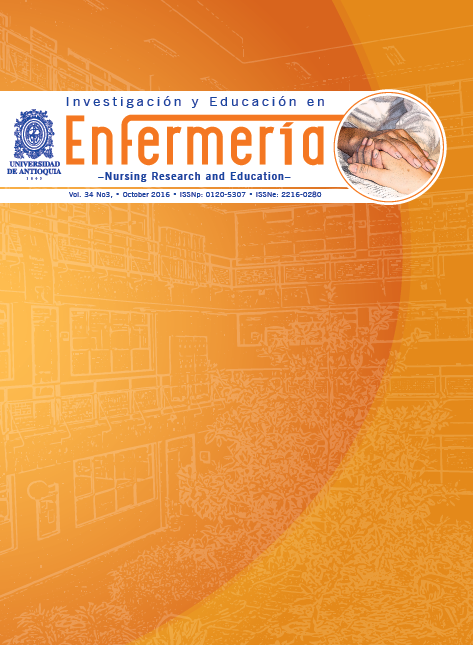Stress among nursing undergraduate students of a Brazilian public university
DOI:
https://doi.org/10.17533/udea.iee.325707Keywords:
Stress, psychological, students, nursing, mental health, education, higher.Abstract
Objective. To determine the level of stress among students of an undergraduate course in nursing of a Brazilian public university.
Methods. Cross-sectional study involving 111 students who responded to the 30 item questionnaire of Costa and Polak for the Assessment of Stress among Nursing Students, with Likert type response options of 0-3 (0 = I have not experienced the situation; 1 = I do not feel stressed with the situation; 2 = I feel a little stressed with the situation, and 3 = I feel very stressed with the situation).
Results. Participants were predominantly single (82.9%), female (83.8%), young adults (mean 23.3 years) and performing some kind of paid work (76.6%). The main stressors were related to the lack of time for: leisure activities (2.6); spending time with family members (2.5) and; completion of extracurricular activities (2.3). The highest levels of stress among students were found in the domains of professional training (52.2%), professional communication (33.3%) and time management (32.4%).
Conclusion. The majority of the students presented low levels of stress in the general activities of the course, however, the activities related to time management, especially time for academic activities and social and family life, were identified as permanent stress factors during the graduation course.
How to cite this article: Souza VS, Costa MAR, Rodrigues AC, Bevilaqua JF, Inoue KC, Oliveira JLC, et al. Stress among nursing undergraduate students of a Brazilian public university. Invest. Educ. Enferm. 2016; 34(3): 518-527.
Downloads
References
(1) Fontana RT, Brigo L. Estudar e trabalhar: percepções de técnicos de enfermagem sobre esta escolha. Esc. Anna Nery. 2011; 16(1):128-33.
(2) Bublitz S, Freitas EO, Kirchhof RS, Lopes LFD, Guido LA. Estressores entre acadêmicos de enfermagem de uma universidade pública. Rev. Enferm. UERJ. 2012; 20(esp.2): 739-45.
(3) Theme Filha MM, Costa MAS, Guilam MCR. Estresse ocupacional e autoavaliação de saúde entre profissionais de enfermagem. Rev. Latino-Am. Enfermagem. 2013; 21(2):475-83.
(4) Faro A, Pereira ME. Estresse: revisão narrativa da evolução conceitual, perspectivas teóricas e metodológicas. Psic. Saúde & Doenças. 2013; 14(1):78-100.
(5) Versa GLGS, Murassaki ACY, Inoue KC, Melo WA, Faller JW, Matsuda LM. Estresse ocupacional: avaliação de enfermeiros intensivistas que atuam no período noturno. Rev. Gaúcha Enferm. 2012, 33 (2):78-85.
(6) Corral-Mulato S, Baldissera VDA, Santos JL, Philbert LAS, Bueno SMV. Estresse na vida do acadêmico em enfermagem. (Des)conhecimento e prevenção. Invest. Educ. Enferm. 2011; 29(1):109-17.
(7) Costa ALS, Polak C. Construção e validação de instrumento para avaliação de estresse em estudantes de enfermagem (AEEE). Rev. Esc. Enferm. USP. 2009; 43(Esp):1017-26.
(8) Moreira DP, Furegato ARF. Estresse e depressão entre alunos do último período de dois cursos de enfermagem. Rev. Latino-Am. Enfermagem. 2013; 21(Esp):155-62.
(9) Benavente SBT, Silva RM, Higashi AB, Guido LA, Costa ALS. Influência de fatores de estresse e características sociodemográficas na qualidade do sono de estudantes de enfermagem. Rev. Esc. Enferm. USP. 2014; 48(3):514-20.
(10) Tomaschewski-Barlem JG, Lunardi VL, Lunardi GL, Barlem ELD, Silveira RS, Vidal DAS. Síndrome de burnout entre estudantes de graduação em enfermagem de uma universidade pública. Rev. Latino-Am. Enfermagem. 2014; 22(6):934-41.
(11) Kim SD. Effects of yogic exercises on life sress and blood glucose levels in nursing students. J. Phy. Ther. Sci. 2014; 26(12):2003-6.
(12) Isfahani HM, Aryankhesal A, Haghani H. The relationship between the managerial skills and results of “performance evaluation” tool among nursing managers in teaching hospitals of Iran University of Medical Science. Glob. J. Health Sci. 2015; 7(2):38-43.
(13) Nechita F, Streba CT, Vere CC, Nechita D, Rogoveanu I. Stress in romanian first year nursing students. Curr. Health Sci. J. 2014; 40(3):210-13.
(14) Souza IMD, Paro HBMS, Morales RR, Pinto RMC, Silva CHM. Health-related quality of life and depressive symptoms in undergraduate nursing students. Rev Latino-Am Enfermagem. 2012; 20(4):736-43.
(15) Hirsch CD, Barlem ELD, Tomaschewski-Barlem JG, Lunardi VL, Oliveira ACC. Preditores do estresse e estratégias de coping utilizadas por estudantes de enfermagem. Acta. Paul. Enferm. 2015; 28(3):224-9.
(16) Souza SNDH, Miyadahira AMK. Desenvolvimento de competências no curso de graduação em enfermagem: percepção de egressos. Cienc. Cuid. Saúde. 2012; 11(suplem.): 243-50.
(17) Reis CT, Martins M, Laguardia J. A segurança do paciente como dimensão da qualidade do cuidado de saúde – um olhar sobre a literatura. Ciência Saúde Colet. 2013; 18(7):2029-36.
(18) Araujo MAN, Lunardi Filho WD, Leite LRC, Ma RTK, Silva AA, Souza JC. Qualidade de vida de estudantes de enfermagem. Rev. Rene. 2014; 15(6):990-7.
Downloads
Published
How to Cite
Issue
Section
License
Derechos de propiedad / Direitos de Propriedade
English: If the article is accepted for publication, all copyright will be of exclusive property of Investigación y Educación en Enfermería. The text and the graphics included in the publication are exclusive responsibility of the authors and not necessarily reflect the thought of the Editorial Committee.
Español: Si el artículo es aprobado para publicación, todos los derechos son de propiedad de Investigación y Educación en Enfermería. El texto y las gráficas incluidas en la publicación son de exclusiva responsabilidad de los autores y no necesariamente refleja el pensamiento del Comité Editorial.
Português: Se o artigo for aceito para publicação, todos os direitos autorais serão de propriedade exclusiva de Investigación y Educación en Enfermería. O texto e os gráficos incluídos na publicação são de responsabilidade exclusiva dos autores e não refletem necessariamente o pensamento do Comitê Editorial.















